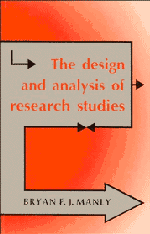Book contents
- Frontmatter
- Contents
- Preface
- 1 Preview
- 2 The sample survey
- 3 Other sampling designs
- 4 The linear regression model
- 5 Experimental designs to assess the effect of a treatment
- 6 Interrupted time series
- 7 More advanced experimental designs
- 8 Some special types of data
- 9 Computer intensive statistics
- 10 Ethical considerations
- 11 Synthesis: carrying out a research study
- References
- Author index
- Subject index
5 - Experimental designs to assess the effect of a treatment
Published online by Cambridge University Press: 05 February 2015
- Frontmatter
- Contents
- Preface
- 1 Preview
- 2 The sample survey
- 3 Other sampling designs
- 4 The linear regression model
- 5 Experimental designs to assess the effect of a treatment
- 6 Interrupted time series
- 7 More advanced experimental designs
- 8 Some special types of data
- 9 Computer intensive statistics
- 10 Ethical considerations
- 11 Synthesis: carrying out a research study
- References
- Author index
- Subject index
Summary
Introduction
As was pointed out in Section 1.6, the subject of experimental design is usually thought of beginning with the work of Sir Ronald Fisher at Rothamstead Experimental Station in Britain, in the early part of this century. Two of his classical books on the subject were Statistical Methods for Research Workers, first published in 1925, and The Design of Experiments, first published in 1935. The subject has come a long way in the years since then, and yet there are still aspects of it that are not covered well in most textbooks. One reason for this is that the theory of experimental design began with applications in agriculture, an area where the researcher has a great deal of freedom to manipulate the experimental materials and to apply different treatments. However, in many other areas there are very real constraints as to what can be done, either for ethical reasons, or because the experimental units are human subjects with minds of their own.
The example of assessing the effect on heart disease of a high or low salt diet that was discussed in Section 1.6 suggests that it is important, at least in some disciplines, to consider potential experimental designs that are less than perfect but at least can be used. It is important, then, to understand the weaknesses of these quasi-experimental designs. Much of the theoretical work in this area has been done by those working in the areas of education research and in the evaluation of social programmes. However, this work is relevant to experimenters in many other subject areas as well.
- Type
- Chapter
- Information
- The Design and Analysis of Research Studies , pp. 132 - 166Publisher: Cambridge University PressPrint publication year: 1992



